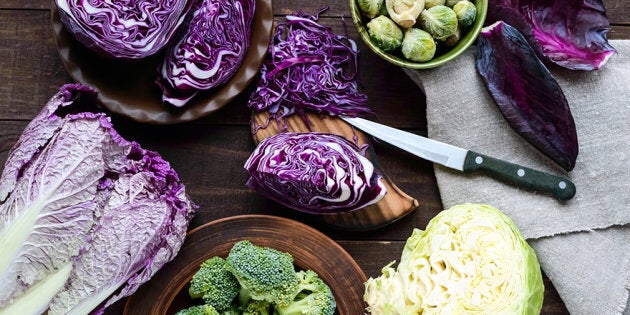
Cabbage was mentioned in Greek botanist Theophrastus' texts in 4th century BC, and has been used as both food and medicine for thousands of years. The first cabbage in North America came via French explorer Jacques Cartier on his third voyage in 1541–1542. And it's a good thing that it was on board his ship! Rich in vitamin C, cabbage was used on long ocean journeys to help prevent scurvy (vitamin C deficiency) among the crew.
These days, it's more likely to see cabbage in coleslaw or sauerkraut than as a scurvy remedy, but its popularity has never waned. Cabbage falls into the same vegetable family as other cruciferous brassicas, including kale, Brussels sprouts, radishes and broccoli. Versatile, affordable and super healthy, it's a great time for active older adults to add cabbage to their plates.
Cabbage nutrition facts and health benefits
1. The calories in cabbage are very low
Wondering how many calories there are in cabbage? One cup of raw, chopped green cabbage has just 24 calories and five grams of carbohydrates. This is likely where the notion of the "cabbage soup diet" came from (spoiler: it's a fad diet and it doesn't actually work for long-term weight control).
2. Cabbage is rich in vitamin C
Cabbage is an excellent source of vitamin C, and a source of fiber and vitamin K. Red cabbage has a similar nutritional value, but is 10 times higher in vitamin A compared to green cabbage.
3. Nutrients in cabbage may help stop cancer
Cruciferous vegetables like cabbage contain glucosinolates, which are sulfur-containing chemicals that give these veggies their distinct aroma and bitter flavour. But glucosinolates do another job, too: they're being studied for their anti-cancer effects. Studies on human cells (in lab settings) have shown that certain glucosinolates may kill cancer cells and help stop metastasis (the spread of cancer cells).
4. Nutrients in cabbage have anti-inflammatory effects
All types of cabbage contain polyphenols that have anti-inflammatory effects, but red cabbage takes the lead for its benefits. Red cabbage contains anthocyanins — they're the same red-blue pigment found in blueberries and concord grapes. It has been suggested that anthocyanins have both anti-inflammatory and anti-cancer activity, because of their potent antioxidant properties.
Cabbage leaves for swelling: folklore or fact?
Cabbage has been touted as a cure-all for swollen feet and sore joints. While it intuitively makes sense, since certain nutrients in cabbage are anti-inflammatory, we couldn't find any clinical studies with evidence that cabbage leaves placed on the skin can work for this purpose.
Raw or cooked, the possibilities with cabbage are endless.
How to add red and green cabbage to your diet
Cabbage is a hardy vegetable that stores well and lasts longer than most leafy green vegetables. In fact, some colder regions of the world rely on cabbage during the winter because it stores so well. It can last for up to two months in the fridge or longer in a cold cellar.
Raw or cooked, the possibilities with cabbage are endless. Whether you prefer green or red cabbage, they're interchangeable in recipes. You can also try savoy cabbage, which has a rippled appearance compared to the smooth flat leaves of green and red cabbage.
Cabbage can be shredded for use in salads or coleslaw. Since cabbage is a multilayered orb, much of the lengthwise cutting is already done for you. So how do you shred cabbage, exactly? Simply cut out the base core (video tutorial) and place the cabbage on a cutting board. Starting from one side, cut down thinly with a sharp knife or run along a mandoline (it's the best cabbage shredder), and you will automatically get fine strands of shredded cabbage.
Cara Rosenbloom is a Toronto-based registered dietitian, writer and recipe developer. She's the co-author of the best-selling cookbook Nourish: Whole Food Recipes featuring Seeds, Nuts and Beans (Whitecap, 2016) and writes a health column for the the Washington Post.
Follow HuffPost Canada Blogs on Facebook